Answered step by step
Verified Expert Solution
Question
1 Approved Answer
. Instructions For this homework you will write a script to do some useful calculations for credit card payments. Use the template provided below. At
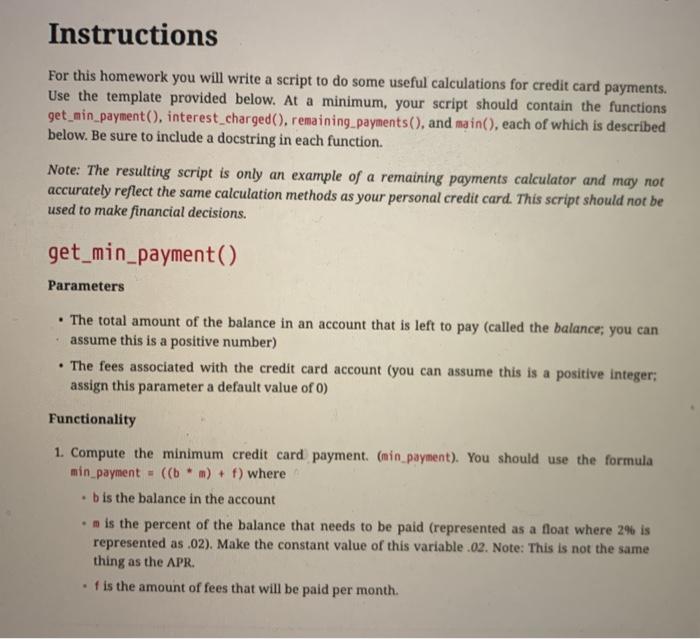

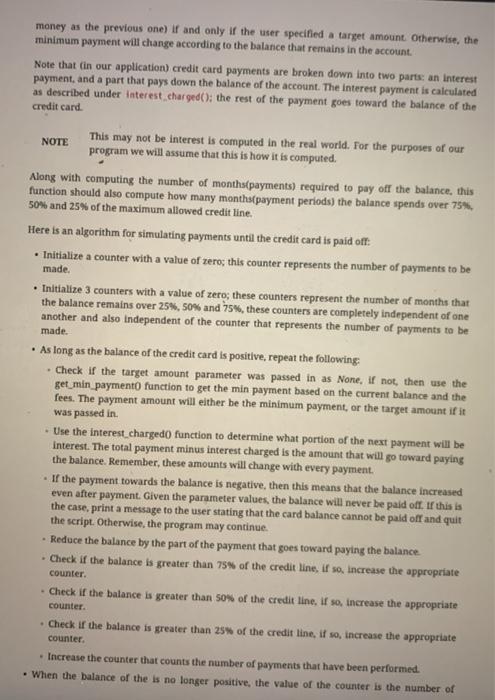

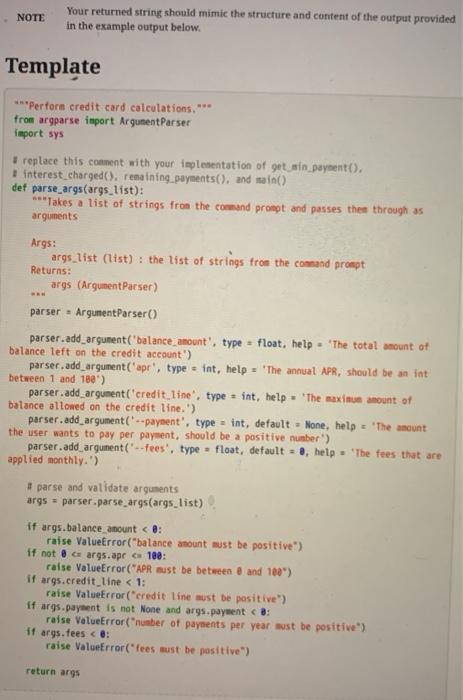
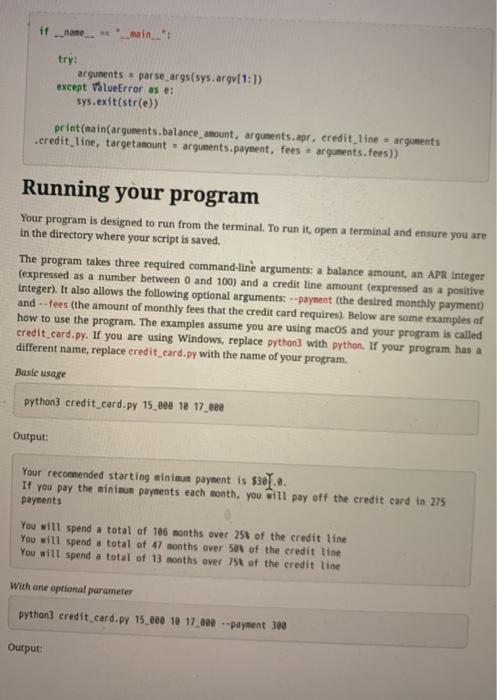
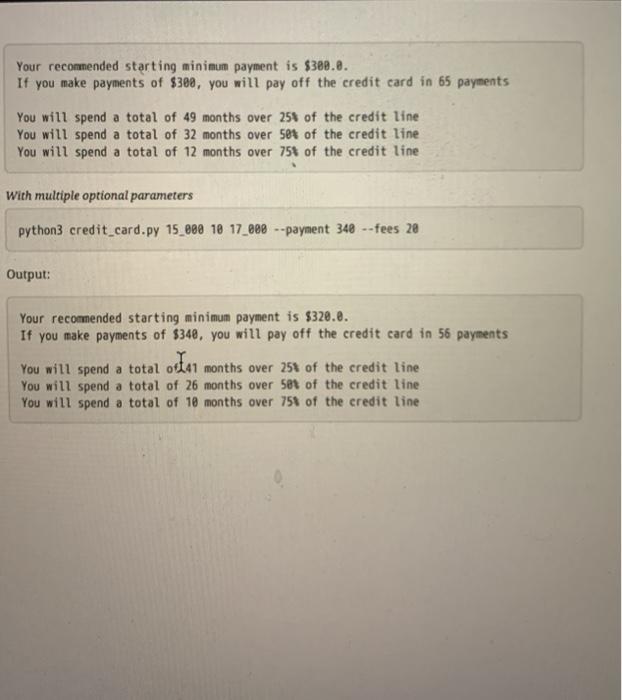
.
Instructions For this homework you will write a script to do some useful calculations for credit card payments. Use the template provided below. At a minimum, your script should contain the functions get_min_payment(), interest_charged(), remaining payments(), and main(), each of which is described below. Be sure to include a docstring in each function. Note: The resulting script is only an example of a remaining payments calculator and may not accurately reflect the same calculation methods as your personal credit card. This script should not be used to make financial decisions. get_min_payment() Parameters The total amount of the balance in an account that is left to pay (called the balance; you can assume this is a positive number) The fees associated with the credit card account (you can assume this is a positive integer; assign this parameter a default value of 0) Functionality 1. Compute the minimum credit card payment. (nin payment). You should use the formula min_payment = ((b + m) + f) where . b is the balance in the account m is the percent of the balance that needs to be paid (represented as a float where 2% is represented as .02). Make the constant value of this variable .02. Note: This is not the same thing as the APR. . f is the amount of fees that will be paid per month 2. Determine if the minimum payment that was computed using the formula is below 25. Iris is we should set the minimum payment to 25 instead. Return this number NOTE This function takes into account only balance, the minimum payment percentage and fees in the real world, minimum credit card payments may take more factors into account interest_charged() Parameters The balance of the credit card the amount in the account that has not been paid off yet, you can assume thists a positive number) The annual APR you can assume this is an integer between 0 and 100, for example, an APR of 5% would be expressed as 5) Functionality Compute and return i, the amount of interest accrued in the next payment according to the formulai (a/)*", where a is the APR expressed as a floating point number(for example, an APR of a would be .08% y is the amount of days in a year b is the balance in the account . d is the number of days in a billing cycle (expressed as an integer, you can safely assume that this will be 30 each time) remaining payments() Parameters The balance of the credit card (that amount in the account that has not been paid off yet you can assume this is a positive number The annual APR (you can assume this is an integer between 0 and 100, for example, an APR of 5% would be expressed as 5) The target payment (the amount the user wants to pay per payment: you can assume this is a positive number The credit line. The maximum amount of balance that an account holder can keep in their account. (you can assume this is a positive integer, defalts to S000) The amount of fees that will be charged in addition to the minimum payment, you can assume this is a positive integer; defaults to 0) Functionality Compute and return the number of payments required to pay of the credit card balance. We will do this by simulating payments one at a time until the balance of the credit card reaches zero. We will be assuming fixed payments in other words, assume that each payment is the same amount of money as the previous one) if and only if the user specified a target amount. Otherwise, the minimum payment will change according to the balance that remains in the account. Note that in our application) credit card payments are broken down into two parts: an interest payment, and a part that pays down the balance of the account. The interest payment is calculated as described under interest charged(); the rest of the payment goes toward the balance of the credit card This may not be interest is computed in the real world. For the purposes of our NOTE program we will assume that this is how it is computed. Along with computing the number of months(payments) required to pay off the balance, this function should also compute how many months(payment periods) the balance spends over 75% 50% and 25% of the maximum allowed credit line. Here is an algorithm for simulating payments until the credit card is paid off: Initialize a counter with a value of zero; this counter represents the number of payments to be made. Initialize 3 counters with a value of zero, these counters represent the number of months that the balance remains over 25%, 50% and 75%, these counters are completely independent of one another and also independent of the counter that represents the number of payments to be made. As long as the balance of the credit card is positive, repeat the following . Check if the target amount parameter was passed in as None, if not, then use the get_min_payment function to get the min payment based on the current balance and the fees. The payment amount will either be the minimum payment, or the target amount if it was passed in Use the interest charged function to determine what portion of the next payment will be interest. The total payment minus interest charged is the amount that will go toward paying the balance. Remember, these amounts will change with every payment If the payment towards the balance is negative, then this means that the balance increased even after payment. Given the parameter values, the balance will never be paid off. If this is the case, print a message to the user stating that the card balance cannot be paid off and quit the script. Otherwise, the program may continue. Reduce the balance by the part of the payment that goes toward paying the balance . Check if the balance is greater than 75% of the credit line, if so increase the appropriate Check if the balance is greater than 50% of the credit line, if so, increase the appropriate . Check if the balance is greater than 25 of the credit line, if so, increase the appropriate counter Increase the counter that counts the number of payments that have been performed. When the balance of the is no longer positive, the value of the counter is the number of counter. counter payments required. Return the counters all together as a tuple. You can return multiple items at once from a function if you separate each item by a comma. The item returned will be a tuple containing the items that you returned. Each element in the tuple can be accessed referencing its respective index NOTE main() Parameters The balance of the credit card (that amount in the account that has not been paid off yet you can assume this is a positive number) The annual APR (you can assume this is an integer between 0 and 100; for example, an APR of 5% would be expressed as 5) The target payment (the amount the user wants to pay per payment, you can assume this is a positive number:defaults to None) The credit line. The maximum amount of balance that an account holder can keep in their account. (you can assume this is a positive integer, defaults to 5,000) The amount of fees that will be charged in addition to the minimum payment. (you can assume this is a positive integer; defaults to 0) Functionality Compute the recommended minimum payment using the get ein payment() function Display the recommended minimum payment to the user Declare a variable named pays minimum to False. This variable represents whether a user has chosen to pay the minimum payment each month or not. If the user's target payment is done, set the pays win in to Trun. Otherwise, the user's target payment is less than the minimum payment, print a message to the user les. "Your target payment is less than the minimum payment for this credit card") and quit the programu otherwise Use remaining payments() to figure out the total number of payments required Chint we will assume that the beginning balance is the balance amount that was passed in If the user pays the minimum payment each time, display the number that represents the number of payments that need to be made to the user leg. "If you pay the minimum payments each month, you will pay off the balance in totalmente payments replace the angle brackets with the appropriate values If the user does not pay the minimum payments, display the number that represents the number of payments that need to be made to the user along with what the desired payment amount is e. "If you make payments of target payment you will pay off the balance in total payments > payments." replace the angle brackets with the appropriate values Return a string that is a message that will tell the user how many payments they will be above 25, 50 and 75 percent thresholds. NOTE Your returned string should mimic the structure and content of the output provided in the example output below. Template ***Perforn credit card calculations. *** fron argparse import ArgumentParser import sys # replace this comment with your implementation of get_sin_payment(). interest_charged(), remaining payments(), and main() det parse_args(args_list): ***Takes a list of strings from the command prompt and passes the through as arguments Args: args list (list) : the list of strings from the command prompt Returns: args (ArgumentParser) parser ArgumentParser() parser.add_argument('balance amount', type - float, help - 'The total amount of balance left on the credit account) parser.add_argument('apr', type = int, help = 'The annual APR, should be an int between 1 and 180) parser.add_argument('credit line', type = int, help - 'The maximum amount of balance allowed on the credit line.) parser.add_argument('--payment', type = int, default - None, help = 'The mount the user wants to pay per payment, should be a positive number) parser.add argument('--fees', type - float, default = help 'The fees that are applied monthly.') #parse and validate arguments args = parser.parse_args(args list) if args.balance amount payments." replace the angle brackets with the appropriate values Return a string that is a message that will tell the user how many payments they will be above 25, 50 and 75 percent thresholds. NOTE Your returned string should mimic the structure and content of the output provided in the example output below. Template ***Perforn credit card calculations. *** fron argparse import ArgumentParser import sys # replace this comment with your implementation of get_sin_payment(). interest_charged(), remaining payments(), and main() det parse_args(args_list): ***Takes a list of strings from the command prompt and passes the through as arguments Args: args list (list) : the list of strings from the command prompt Returns: args (ArgumentParser) parser ArgumentParser() parser.add_argument('balance amount', type - float, help - 'The total amount of balance left on the credit account) parser.add_argument('apr', type = int, help = 'The annual APR, should be an int between 1 and 180) parser.add_argument('credit line', type = int, help - 'The maximum amount of balance allowed on the credit line.) parser.add_argument('--payment', type = int, default - None, help = 'The mount the user wants to pay per payment, should be a positive number) parser.add argument('--fees', type - float, default = help 'The fees that are applied monthly.') #parse and validate arguments args = parser.parse_args(args list) if args.balance amount Step by Step Solution
There are 3 Steps involved in it
Step: 1

Get Instant Access to Expert-Tailored Solutions
See step-by-step solutions with expert insights and AI powered tools for academic success
Step: 2

Step: 3

Ace Your Homework with AI
Get the answers you need in no time with our AI-driven, step-by-step assistance
Get Started


